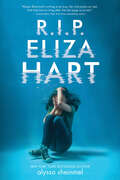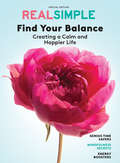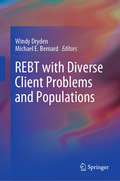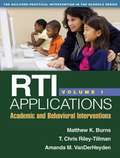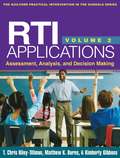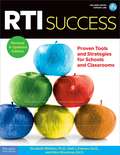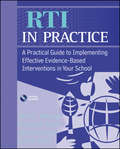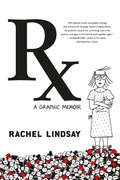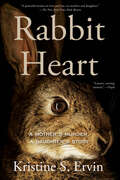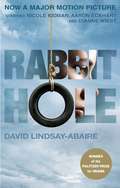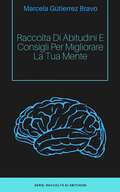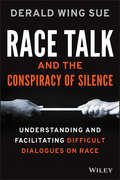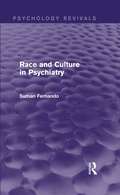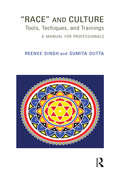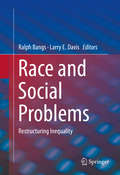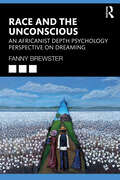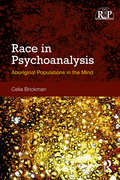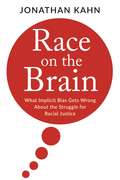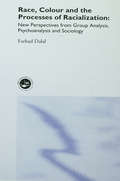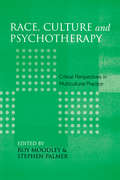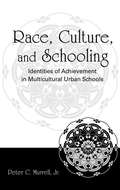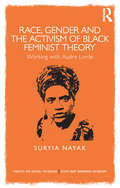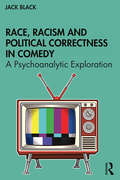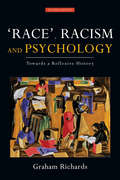- Table View
- List View
R.I.P. Eliza Hart
by Alyssa SheinmelA gorgeous and haunting contemporary YA in the tradition of We Were Liars.When Eliza Hart, the most popular girl at Ventana Ranch boarding school, is found dead, Ellie Sokoloff is determined to figure out what happened to her. After all, Eliza was Ellie's childhood best friend. Never mind that ever since Ellie arrived at school Eliza has spread terrible rumors about her, calling her a liar and a stalker, when all Ellie wanted to do was rekindle their old friendship. Or that Ellie's claustrophobia limits where she can go and what she can do. Or that Ellie's suitemate, Sam, is the only one who will help her . . . because to everyone else, Ellie looks like the top suspect.Can Ellie clear her name and solve the mystery behind Eliza's death? Her hunt for the truth will uncover secrets she never imagined, sending her deep into her own memories of her childhood with Eliza Hart.New York Times bestselling author Alyssa Sheinmel delivers a gripping mystery and a sensitive and moving examination of the secrets that can hold us back--and even destroy us.
REAL SIMPLE Find Your Balance: Creating a Calm and Happier Life
by The Editors of Real SimpleSlow down, strip away stress, and save your sanity with this practical guide to creating a better life. Let the experts at Real Simple, America's beloved guide to living a better and more authentic life, show you how to relax and get the most out of your days.
REBT in the Treatment of Anxiety Disorders in Children and Adults
by Ioana Alina Cristea Simona Stefan Oana David Cristina Mogoase Anca DobreanThis clinical guide reviews the basics of Rational Emotive Behavior Therapy and presents a quartet of tested protocols for treating anxiety disorders in children and adults. Adult applications feature REBT for treating generalized anxiety disorder and a brief REBT/virtual reality immersion approach to social anxiety disorder. For children and adolescents, a REBT and a rational-emotive educational program address anxiety with interventions tailored to age and developmental considerations. Each protocol suggests measures for screening for suitability and differential diagnosis, explains the usefulness of REBT for the problem, and includes these features: Session-by-session therapist guide with case formulation and relevant techniques. In-session evaluation scales. Client worksheets and exercises. Developmentally appropriate materials for children and adolescents. Agendas for parent sessions to supplement children's therapy. Recommended readings for clients and reference lists for therapists. REBT in the Treatment of Anxiety Disorders in Children and Adults offers a wealth of proven hands-on knowledge not only for practitioners using REBT in their work, such as therapists, clinical psychologists, and counselors, but also for researchers studying the efficacy of psychotherapy interventions for anxiety disorders.
REBT with Diverse Client Problems and Populations
by Michael E. Bernard Windy DrydenThis practice-focused resource demonstrates effective uses of Rational Emotive Behavior Therapy methods and techniques in treating clients across various conditions, settings, and subgroups. Client problems featured include both those often associated with REBT (e.g., anxiety, depression, anger) and others noted for complex presentations, difficulties with engagement, and impasses (e.g., addictions, suicidality, psychosis). Challenging treatment populations are covered as well, including women, couples, families, elder and pediatric clients, clients with disabilities, and sexual minorities. These stimulating cases show how well the diversity of clients and their concerns is matched by the flexibility of techniques and applications within REBT. In each chapter, expert therapists: · Identify concepts in REBT especially suited to approaching the problem or population. · Outline best REBT practices in assessment and treatment of the client(s). · Survey evidence-based non-REBT approaches most useful in complementing REBT. · Provide a brief case example representing appropriate REBT in action. · Assess their use of REBT in treating the problem or members of the population. A bedrock text for REBT scholar-practitioners, REBT with Diverse Populations and Problems is a testimony to the continuing usefulness of the therapy and its adaptability as client populations emerge and as the contexts of client problems evolve in response to a demanding world.
RTI Applications, Volume 1: Academic and Behavioral Interventions (The Guilford Practical Intervention in the Schools Series #1)
by Matthew K. Burns T. Chris Riley-Tillman Amanda M. VanDerHeydenThis book addresses a crucial aspect of sustaining a response-to-intervention (RTI) framework in a school: selecting interventions with the greatest likelihood of success and implementing them with integrity. Leading RTI experts explain how to match interventions to students' proficiency levels, drawing on cutting-edge research about the stages of learning. Effective academic and behavioral interventions for all three tiers of RTI are described in step-by-step detail and illustrated with vivid case examples. In a large-size format with lay-flat binding for easy photocopying, the book features more than 40 reproducible planning tools and other helpful forms. Purchasers also get access to a Web page where they can download and print the reproducible materials.
RTI Applications: Assessment, Analysis, And Decision Making (The Guilford Practical Intervention In The Schools Series #Volume 2)
by Matthew K. Burns T. Chris Riley-Tillman Kimberly Gibbons"This book addresses a crucial aspect of sustaining a response-to-intervention (RTI) framework in a school: selecting interventions with the greatest likelihood of success and implementing them with integrity. <P><P>Leading RTI experts explain how to match interventions to students' proficiency levels, drawing on cutting-edge research about the stages of learning. <P><P>Effective academic and behavioral interventions for all three tiers of RTI are described in step-by-step detail and illustrated with vivid case examples. <P><P>In a large-size format with lay-flat binding for easy photocopying, the book features more than 40 reproducible planning tools and other helpful forms."
RTI Success: Proven Tools And Strategies For Schools And Classrooms
by Elizabeth Whitten Kelli J. Esteves Alice WoodrowThis practical, ready-to-use resource gives teachers and administrators the tools to successfully implement RTI or strengthen an existing program to target students' specific needs. Response to Intervention allows educators to assess and meet the needs of struggling students before they have fallen too far behind. Three expert authors explore this multi-tiered system of support (MTSS), offering over one hundred research-based, instructional techniques and interventions for use in diverse settings, advice on creating personal and positive learning environments, information on co-teaching, and approaches to purposeful grouping. Included in the book and as digital downloads are easy-to-use customizable forms to streamline assessment, implementation, and documentation. Also included is an extensive list of references and resources for further exploration.
RTI in Practice: A Practical Guide to Implementing Effective Evidence-Based Interventions in Your School
by Wright Mcdougal James A. James L. Graney Suzanne B. Ardoin Scott P.A must-have resource for educational professionals implementing Response to Intervention (RTI) programs in their schools RTI in Practice: A Practical Guide to Implementing Effective Evidence-Based Interventions in Your School is an innovative and timely guide that presents concrete, balanced perspectives and directions for implementing an effective RTI model in your school. Built upon the three tiers of effective general education and universal screening, targeted interventions, and intensive interventions, this authoritative resource addresses: Effective academic programs for all students How to use data to make decisions in general education Guidelines for setting goals, monitoring progress, and graphing intervention outcomes Multicultural considerations Realistic case scenarios appear throughout to bring the implementation strategies to life, and the book is packaged with a CD-ROM containing numerous reproducible and customizable forms, surveys, and screening tools, as well as an annotated list of resources for charting and monitoring individual student and classroom progress. RTI in Practice: A Practical Guide to Implementing Effective Evidence-Based Interventions in Your School is a complete resource providing educators and school professionals with the tips?and tools needed for successful RTI program implementation.
RX
by Rachel LindsayA graphic memoir about the treatment of mental illness, treating mental illness as a commodity, and the often unavoidable choice between sanity and happiness.In her early twenties in New York City, diagnosed with bipolar disorder, Rachel Lindsay takes a job in advertising in order to secure healthcare coverage for her treatment. But work takes a strange turn when she is promoted onto the Pfizer account and suddenly finds herself on the other side of the curtain, developing ads for an antidepressant drug. She is the audience of the work she's been pouring over and it highlights just how unhappy and trapped she feels, stuck in an endless cycle of treatment, insurance and medication. Overwhelmed by the stress of her professional life and the self-scrutiny it inspires, she begins to destabilize and while in the midst of a crushing job search, her mania takes hold. Her altered mindset yields a simple solution: to quit her job and pursue life as an artist, an identity she had abandoned in exchange for medical treatment. When her parents intervene, she finds herself hospitalized against her will, and stripped of the control she felt she had finally reclaimed. Over the course of her two weeks in the ward, she struggles in the midst of doctors, nurses, patients and endless rules to find a path out of the hospital and this cycle of treatment. One where she can live the life she wants, finding freedom and autonomy, without sacrificing her dreams in order to stay well.
Rabbit Heart: A Mother's Murder, a Daughter's Story
by Kristine S. ErvinA Washington Post &“Most Anticipated&” Book of the Year • A New York Times &“Must Read&” • Longlisted for the Reading the West Book AwardsFor readers of My Dark Places and The Fact of a Body, a beautiful, brutal memoir documenting one woman&’s search for identity alongside her family's decades-long quest to identify the two men who abducted—and murdered—her mother"Melding true crime with memoir, Ervin reminds us of what happens when we conflate people with the transgressions committed against them—the collateral damage we inflict when we turn human beings into moral allegory . . . A powerful treatise on love and loss, on mothers and daughters, but it is also a warning to all of us who consume true crime." —The New York Times Book ReviewKristine S. Ervin was just eight years old when her mother, Kathy Sue Engle, was abducted from an Oklahoma mall parking lot and violently murdered in an oil field. First, there was grief. Then the desire to know: what happened to her, what she felt in her last terrible moments, and all she was before these acts of violence defined her life.In her mother&’s absence, Ervin tries to reconstruct a woman she can never fully grasp—from her own memory, from letters she uncovers, and from the stories of other family members. As more information about her mother's death comes to light, Ervin&’s drive to know her mother only intensifies, winding into her own fraught adolescence. She reckons with contradictions of what a woman is allowed to be—a self beyond the roles of wife, mother, daughter, victim—what a &“true&” victim is supposed to look like, and, finally, how complicated and elusive justice can be.Told fearlessly and poetically, Rabbit Heart weaves together themes of power, gender, and justice into a manifesto of grief and reclamation: our stories do not need to be simple to be true, and there is power in the telling.
Rabbit Hole (movie tie-in)
by David Lindsay-AbaireMovie tie-in edition of the film from Lions Gate starring Nicole Kidman, Aaron Eckhart and Dianne Wiest. Life for a happy couple is turned upside down after their young son dies in an accident.
Raccolta di Abitudini e Consigli per Migliorare la tua Mente.
by Marcela Gutiérrez BravoCi sono delle preziosissime informazioni, però esse si possono trovare nei blog specializzati o in articoli molto lunghi che poca gente ha voglia di leggere durante la sua breve navigazione di routine. È per questa ragione che ho deciso di fare questa raccolta. A un libro viene riservato un trattamento differente, viene dedicato del tempo diverso, un momento diverso rispetto a quello che viene dato alla navigazione in rete che, solitamente, a malapena ci dà il tempo di vedere ciò che le persone che ci interessano pubblicano, o di distrarci, o migliorare il nostro umore, in un certo senso stressato per il folle ed interminabile movimento dei tempi che stiamo vivendo. Per questo ho cercato di presentare il materiale nel modo più piacevole possibile e in piccoli capitoli in modo tale da poter essere letti in fila d’attesa, nei mezzi di trasporto, a giornata finita o quando dobbiamo aspettare qualcuno. Tutti i libri di questa raccolta iniziano con la stessa guida per acquisire o eliminare le abitudini, nella prima parte in maniera generale, la seconda è una raccolta di idee specifiche sull’argomento da discutere e la terza parte è un insieme di citazioni che possono servire come stato da condividere sui nostri social network o come promemoria del nostro impegno.
Race Talk and the Conspiracy of Silence
by Derald Wing SueLearn to talk about race openly, honestly, and productively Most people avoid discussion of race-related topics because ofthe strong emotions and feelings of discomfort that inevitablyaccompany such conversations. Rather than endure the conflict ofracial realities, many people choose instead to avoid the topicaltogether, or remain silent when it is raised. Race Talk andthe Conspiracy of Silence: Understanding and Facilitating DifficultDialogues on Race puts an end to that dynamic by sharingstrategies for smoothing conversations about race in a productivemanner.A guide for facilitating and participating in difficultdialogues about race, author Derald Wing Sue - aninternationally recognized expert on multiculturalism, diversity,and microaggressions - explores the characteristics,dynamics, and meaning behind discussions about race as well as thehidden "ground rules" that inhibit honest and productive dialogue.Through emotional and visceral examples, this book explains whyconversations revolving around racial issues are so difficult, andprovides guidelines, techniques, and advice for navigating andleading honest and forthright discussions. Readers will develop astronger ability to build rapport with people unlike themselves,and discover how not talking about race impacts society as awhole.Overcome and make visible the fears associated with racetalkLearn practical ideas for talking openly about raceFacilitate and navigate discussion with expert strategyExamine the hidden rules that govern race talkUnderstand the benefits of successful conversationsDiscussions about race do not have to result in disastrousconsequences, and can in fact be highly beneficial to all partiesinvolved. It's important that people have the ability to converseopenly and honestly with their students, colleagues, children, andneighbors, and Race Talk provides the path for achievingthis goal.
Race and Culture in Psychiatry (Psychology Revivals)
by Suman FernandoAs psychiatry has developed it has proved to be susceptible to the influence of contemporary social and political mores. With its origins in nineteenth-century Europe, psychiatry evolved as an ethnocentric body of knowledge, the vehicle of implicit and overt racism. Originally published in 1988 this author, however, saw no reason why the contemporary psychiatrist should not challenge this ethnocentrism. He provides a critical account of the development of psychiatry in relation to its cultural context and then examined contemporary practice of the time in the light of this development. Throughout, the book is informed by an awareness of issues of race and culture and of their difficult interactions, the author emphasising both the frequency of racist attitudes and the very real cultural distinctions in our society, distinctions that can be used to mask what are actually racist sentiments. What emerges is not just a plea for an anti-racist, culture sensitive psychiatry, but a blueprint for how this can be brought about. He argued that the shift towards community work and social psychiatry could reorientate the profession by confronting it with its social setting and responsibilities. This book represented a significant contribution to this literature for all mental health professionals and social scientists with an interest in this field at the time; the author has gone on to write many more.
Race and Culture: Tools, Techniques and Trainings: A Manual for Professionals (The Systemic Thinking and Practice Series)
by Sumita Dutta Reenee Singh"Race" and Culture: Tools, Techniques and Trainings is a practical resource for trainers who wish to work with the issues raised by racial and cultural diversity in their own agency settings. It is intended as an easy guide and a "hands-on" tool for practitioners (family therapists, clinical psychologists, social workers, GPs, nurses, health visitors, counsellors, teachers, etc), academics, educators and students. It brings together contributions from professional trainers working in multiple and diverse settings. It is aimed both at those who would like to initiate training on diversity in their agency contexts or those who wish to include the important dimensions of "race" and culture into their existing trainings. This book emerged directly from training developed by the authors for professionals working with refugees in their own communities, at the Centre for Cross Cultural Studies at the Institute of Family Therapy.
Race and Social Problems
by Larry E. Davis Ralph BangsAs much as Americans believe in the promise of an egalitarian, color-blind society, the reality is far from that ideal. People of color consistently lag behind their white counterparts in key quality-of-life areas. Despite many significant gains, widespread structural inequalities continue to exist and thrive. Race and Social Problems takes the long view of this state of affairs, offering both multi-level analysis and a practical blueprint for social justice. It begins by explaining how race-related social problems have changed over the decades. This volume identifies factors contributing to their persistence in this century, most notably the central role of economic disparities in exacerbating related social problems and replicating them for future generations. The chapters expand on this knowledge by detailing innovative and successful strategies for addressing aspects of six major areas of inequality: Poverty: challenging standard American concepts of poverty. Education: approaches toward closing the achievement gap. Intergroup relations: enhancing race dialogues. Family and lifespan: programs targeting families, youth, and elderly. Criminal justice: reducing incarceration and increasing public safety. Health and mental health: promoting positive outcomes. Race and Social Problems casts a wide net across the most pressing social issues, clarifying both the immediate and larger tasks ahead for a range of professionals in such diverse fields as social work, anthropology, communications, criminology, economics, history, law, political science, psychology, public health, and sociology.
Race and the Unconscious: An Africanist Depth Psychology Perspective on Dreaming
by Fanny BrewsterRace and the Unconscious engages the archetypal African consciousness that enriches our knowledge regarding the foundational mythopoetic of Africanist dreaming. Featuring crucial historical context, Jungian and post-Jungian theory, clinical case studies, and dream series interpretations, the book offers readers a rich framework for exploring and understanding the language, images, and symbols of African and African American dreamlife. It expands the modern understanding of dreaming with the inclusion of Africanist perspectives, philosophy, and mythology while emphasizing the potential for and process of psychological healing through dreamwork. Race and the Unconscious is a must-read for Jungian analysts and analytical psychologists in practice and in training, as well as anyone interested in understanding psychological processes inclusive of those of African descent and their culture, including academics and students of sociology, anthropology, African American studies, and African diaspora studies.
Race in Psychoanalysis: Aboriginal Populations in the Mind (Relational Perspectives Book Series)
by Celia BrickmanRace in Psychoanalysis analyzes the often-unrecognized racism in psychoanalysis by examining how the colonialist discourse of late nineteenth-century anthropology made its way into Freud’s foundational texts, where it has remained and continues to exert a hidden influence. Recent racial violence, particularly in the US, has made many realize that academic and professional disciplines, as well as social and political institutions, need to be re-examined for the racial biases they may contain. Psychoanalysis is no exception. When Freud applied his insights to the history of the psyche and of civilization, he made liberal use of the anthropology of his time, which was steeped in colonial, racist thought. Although it has often been assumed that this usage was confined to his non-clinical works, this book argues that through the pivotal concept of "primitivity," it fed back into his theories of the psyche and of clinical technique as well. Celia Brickman examines how the discourse concerning the presumed primitivity of colonized and enslaved peoples contributed to psychoanalytic understandings of self and raced other. She shows how psychoanalytic constructions of race and gender are related, and how Freud’s attitudes towards primitivity were related to the anti-Semitism of his time. All of this is demonstrated to be part of the modernist aim of psychoanalysis, which seeks to create a modern subjectivity through a renegotiation of the past. Finally, the book shows how all of this can affect both clinician and patient within the contemporary clinical encounter. Race in Psychoanalysis is a pivotal work of significance for scholars, practitioners and students of psychoanalysis, psychologists, clinical social workers, and other clinicians whose work is informed by psychoanalytic insights, as well as those engaged in critical race and postcolonial studies.
Race on the Brain: What Implicit Bias Gets Wrong About the Struggle for Racial Justice
by Jonathan KahnOf the many obstacles to racial justice in America, none has received more recent attention than the one that lurks in our subconscious. As social movements and policing scandals have shown how far from being “postracial” we are, the concept of implicit bias has taken center stage in the national conversation about race. Millions of Americans have taken online tests purporting to show the deep, invisible roots of their own prejudice. A recent Oxford study that claims to have found a drug that reduces implicit bias is only the starkest example of a pervasive trend. But what do we risk when we seek the simplicity of a technological diagnosis—and solution—for racism? What do we miss when we locate racism in our biology and our brains rather than in our history and our social practices?In Race on the Brain, Jonathan Kahn argues that implicit bias has grown into a master narrative of race relations—one with profound, if unintended, negative consequences for law, science, and society. He emphasizes its limitations, arguing that while useful as a tool to understand particular types of behavior, it is only one among several tools available to policy makers. An uncritical embrace of implicit bias, to the exclusion of power relations and structural racism, undermines wider civic responsibility for addressing the problem by turning it over to experts. Technological interventions, including many tests for implicit bias, are premised on a color-blind ideal and run the risk of erasing history, denying present reality, and obscuring accountability. Kahn recognizes the significance of implicit social cognition but cautions against seeing it as a panacea for addressing America’s longstanding racial problems. A bracing corrective to what has become a common-sense understanding of the power of prejudice, Race on the Brain challenges us all to engage more thoughtfully and more democratically in the difficult task of promoting racial justice.
Race, Colour and the Processes of Racialization: New Perspectives from Group Analysis, Psychoanalysis and Sociology
by Farhad DalalIs racial conflict determined by biology or society?So many conflicts appear to be caused by racial and ethnic differences; for example, the cities of Britain and America are regularly affected by race riots. It is argued by socio-biologists and some schools of psychoanalysis that our instincts are programmed to hate those different to us by evolutionary and developmental mechanisms. This book argues against this line, proposing an alternative drawing on insights from diverse disciplines including anthropology, social psychology and linguistics, to give power-relations a critical explanatory role in the generation of hatreds. Farhad Dalal argues that people differentiate between races in order to make a distinction between the 'haves' and 'must-not-haves', and that this process is cognitive, emotional and political rather than biological. Examining the subject over the past thousand years, Race, Colour and the Processes of Racialisation covers:* psychoanalytic and other theories of racism* a new theorisation of racism based on group analytic theory* a general theory of difference based on the works of Fanon, Elias, Matte-Blanco and Foulkes* application of this theory to race and racism.Farhad Dalal concludes that the structures of society are reflected in the structures of the psyche, and both of these are colour coded. This book will be invaluable to students, academics and practitioners in the areas of psychoanalysis, group analysis, psychotherapy and counselling.
Race, Culture and Psychotherapy: Critical Perspectives in Multicultural Practice
by Stephen Palmer Roy MoodleyWhat is multicultural psychotherapy? How do we integrate issues of gender, class and sexual orientation in multicultural psychotherapy? Race, Culture and Psychotherapy provides a thorough critical examination of contemporary multiculturalism and culturalism, including discussion of the full range of issues, debates and controversies that are emerging in the field of multicultural psychotherapy. Beginning with a general critique of race, culture and ethnicity, the book explores issues such as the notion of interiority and exteriority in psychotherapy, racism in the clinical room, race and countertransference conflicts, spirituality and traditional healing issues. Contributors from the United States, Britain and Canada draw on their professional experience to provide comprehensive and balanced coverage of the following subjects: critical perspectives in race and culture in psychotherapy governing race in the transference racism, ethnicity and countertransference intersecting gender, race, class and sexual orientation spirituality, cultural healing and psychotherapy future directions Race, Culture and Psychotherapy will be of interest not only to practicing psychotherapists, but also to students and researchers in the field of mental health and anyone interested in gaining a better understanding of psychotherapy in a multicultural society.
Race, Culture, and Schooling: Identities of Achievement in Multicultural Urban Schools
by Peter C. Murrell, Jr.Responding to a need for greater cultural competence in the preparation and development of teachers in diverse public school settings, this book investigates the critical developmental and social processes mediating students’ academic identities in those settings posing the greatest challenges to their school achievement and personal development. It provides an accessible, practice-oriented culturally responsive framework for teachers in American schools. Murrell proposes a situated-mediated identity theory that emphasizes examining not just the child, not just the school environment, but also the child in-context as the unit of analysis to understand how both mutually constitute each other in the social and cultural practices of schooling. He then develops this theory into an applied psychology of identity and agency development among children and youth as well as their teachers, striving together for academic achievement in diverse school settings. For researchers, professionals, and students in multicultural education, educational and developmental psychology, social and cultural foundations of education, and teacher education, Murrell’s cultural practices approach builds on current thinking about multicultural teacher preparation and provides the practice component underpinning theories about cultural competence.
Race, Gender and the Activism of Black Feminist Theory: Working with Audre Lorde (Concepts for Critical Psychology)
by Suryia NayakBeginning from the premise that psychology needs to be questioned, dismantled and new perspectives brought to the table in order to produce alternative solutions, this book takes an unusual transdisciplinary step into the activism of Black feminist theory. The author, Suryia Nayak, presents a close reading of Audre Lorde and other related scholars to demonstrate how the activism of Black feminist theory is concerned with issues central to radical critical thinking and practice, such as identity, alienation, trauma, loss, the position and constitution of individuals within relationships, the family, community and society. Nayak reveals how Black feminist theory seeks to address issues that are also a core concern of critical psychology, including individualism, essentialism and normalization. Her work grapples with several issues at the heart of key contemporary debates concerning methodology, identity, difference, race and gender. Using a powerful line of argument, the book weaves these themes together to show how the activism of Black feminist theory in general, and the work of Audre Lorde in particular, can be used to effect social change in response to the damaging psychological impact of oppressive social constructions. Race, Gender and the Activism of Black Feminist Theory will be of great interest to advanced students, researchers, political activist and practitioners in psychology, counselling, psychotherapy, mental health, social work and community development.
Race, Racism and Political Correctness in Comedy: A Psychoanalytic Exploration
by Jack BlackIn what ways is comedy subversive? This vital new book critically considers the importance of comedy in challenging and redefining our relations to race and racism through the lens of political correctness. By viewing comedy as both a constitutive feature of social interaction and as a necessary requirement in the appraisal of what is often deemed to be ‘politically correct’, this book provides an innovative and multidisciplinary approach to the study of comedy and popular culture. In doing so, it engages with the social and cultural tensions inherent to our understandings of political correctness, arguing that comedy can subversively redefine our approach to ‘PC Debates’, contestations surrounding free speech and the popular portrayal of political correctness in the media and society. Aided by the work of both Slavoj Žižek and Alenka Zupančič, this unique analysis adopts a psychoanalytic/philosophical framework to explore issues of race, racism and political correctness in the widely acclaimed BBC ‘mockumentary’, The Office (UK), as well as a variety of television comedies. Drawing from psychoanalysis, social psychology and philosophy, this book will be highly relevant for postgraduate students and academic researchers studying comedy, race/racism, multiculturalism, political correctness and television/film.
Race, Racism and Psychology, 2nd Edition: Towards a Reflexive History
by Graham RichardsThis book offers a comprehensive overview of the ways in which Psychology has engaged with 'race' and racism issues since the late 19th century. It emphasizes the complexities and convolutions of the story and attempts to elucidate the subtleties and occasional paradoxes that have arisen as a result. This new edition updates the research contained in the first edition and includes brand new chapters. These additional chapters draw attention to the importance of the South African Black Consciousness movement and ‘Post-colonial’ Psychology, ?explore recent additional historical research on the fears of ‘hybridisation’, contain new material on French colonial psychiatry, and discuss the awkward status of virtually all the language and terms currently used for discussion of the topic. This important and controversial book has proved to be a vital text, both as a point of departure for more in-depth inquiries, and also as an essential reference tool.The additional up-to-date material included in this new edition makes the book an even more valuable resource to those working in and studying psychology, and also for anyone concerned with the ‘race’ issue either professionally or personally.
